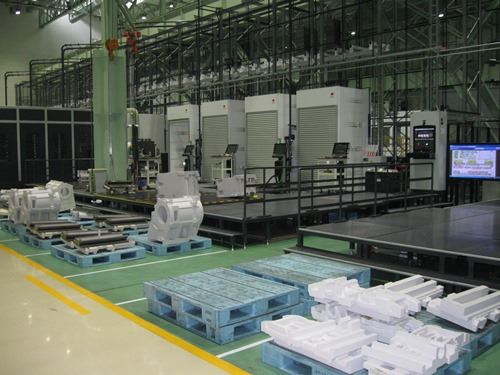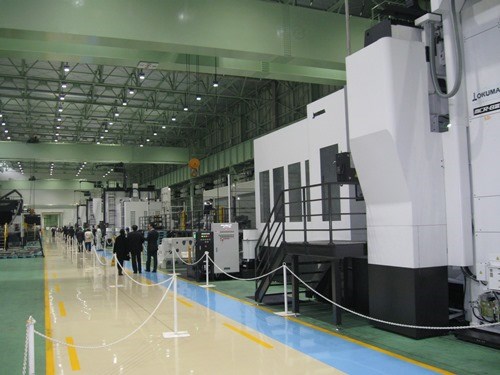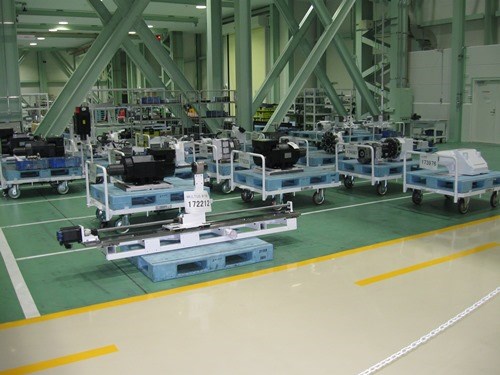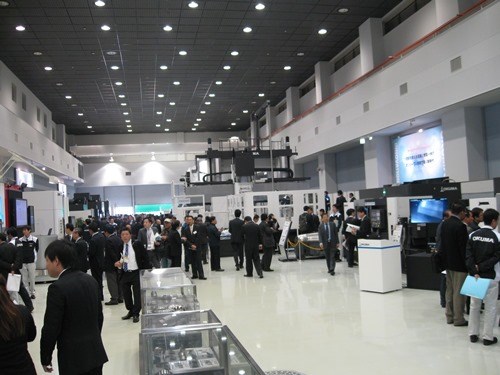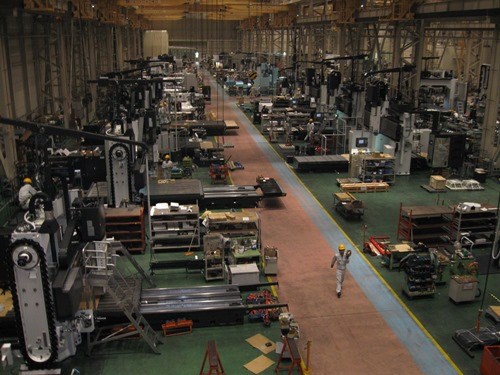New Okuma Plant Relies on Automation, Production Control
The company says the DS1 facility in Japan is capable of 2 times the production capacity and 1/2 the lead time of the previous site.
Share






Hwacheon Machinery America, Inc.
Featured Content
View More

With its newest manufacturing facility in Oguchi, Japan, machine tool builder Okuma literally has made a clean break from its previous approaches to production. The manufacturing facility that previously stood on the site of this plant was leveled in 2012. On May 20, 2013, the company completed construction of the replacement plant, DS1, a 254,000-square-foot facility for the production of CNC lathes and multitasking machines. The first of an expected series of so-called “Dream Site” facilities, the DS1 plant is capable of 2 times the production and 1/2 the lead time of the facility it replaced. Staffing, meanwhile, is roughly the same.
The company says that increasing manufacturing capacity in Japan was necessary to its aim of increasing sales volume outside of Japan. While serving various machining needs in various industries and international markets has led to an expanded product line, competing effectively in those markets requires the company to achieve not just competitive pricing but also competitive delivery. The result is a challenge that many of Okuma’s customers would immediately recognize: the need to manufacture responsively and cost-effectively in an environment of high product variety and low production volumes. The now-operational DS1 facility is the company’s answer to this challenge.
The facility was open to the public in November as part of the company’s Okuma Machine Fair 2013 open house, and I had the chance at this event to talk about the facility with company president and CEO Yoshimaro (Dean) Hanaki. For Okuma, overcoming the high-mix/low-volume challenge entailed all of these elements:
●Automation. The principal way the plant expanded capacity was not by adding space or people, but by taking advantage of time that formerly went unused. In the past, says Mr. Hanaki, production would stop during the night and on weekends. In the new plant, automation is used extensively to enable machines to keep producing when staffing is slight.
That automation consists of robot loading of machine tools in some cases. However, the most visible and extensive type of automation in the shop is the flexible manufacturing system. Various lines in the facility consist of multiple Okuma machining centers united by a Fastems pallet loading system, which in turn draws work from a multi-story rack of pallets accommodating the setups for numerous part numbers. By swapping pallets in and out of the machines as frequently as needed, this configuration enables the machining centers to keep running efficiently even though batch sizes are small and the variety of machined parts is large.
The approach even makes sense when the parts themselves are large. The biggest of DS1’s FMS cells is 120 meters long. The Fastems system in this case unites four Okuma double-column machining centers that each has 2.5 meters between columns. This FMS for large parts machines 80 of the plant’s biggest part numbers.
●Consolidation. Following an approach that is practically the opposite of outsourcing, the DS1 plant seeks cost efficiency by combining nearly all of the steps in machine tool production under one roof. Raw material input, machining, kitting, subassembly, final assembly, inspection and shipping all occur within the facility.
A philosophy of consolidation drives the plant’s approach to assembly as well. Machines do not move from station to station as they are being built. Instead, for greater simplicity, each machine remains in one place on the assembly floor, with components and subassemblies all carted to the machines as they are needed.
●Production control. While the company was building this new plant, it was also building the information system essential to making it work. A production control system coordinates orders and manufacturing capacity in order to schedule part numbers productively on the FMS lines, and also to ensure that parts are delivered just as they are needed to machines being assembled.
Mr. Hanaki says the development of this system, though less visible than other resources in the plant, represents a significant share of the engineering that went into making this facility a success. Without a comprehensive system able to rationalize numerous orders into an as-needed component production and delivery schedule, the only alternative would be to maintain large inventories to ensure that needed components are available. The danger, he says, is that the production facility can come to resemble a warehouse.
●Energy savings. One other significant source of production expense is energy. The DS1 plant saves this cost by combining energy-conserving features such as LED lighting with renewable power generation through solar panels on the roof and one of the building’s walls. Compared to plant it replaced, this plant’s energy consumption is 30 percent less.
Related Content
How to Determine the Currently Active Work Offset Number
Determining the currently active work offset number is practical when the program zero point is changing between workpieces in a production run.
Read MoreInside a CNC-Machined Gothic Monastery in Wyoming
An inside look into the Carmelite Monks of Wyoming, who are combining centuries-old Gothic architectural principles with modern CNC machining to build a monastery in the mountains of Wyoming.
Read MoreHigh RPM Spindles: 5 Advantages for 5-axis CNC Machines
Explore five crucial ways equipping 5-axis CNC machines with Air Turbine Spindles® can achieve the speeds necessary to overcome manufacturing challenges.
Read MoreBallbar Testing Benefits Low-Volume Manufacturing
Thanks to ballbar testing with a Renishaw QC20-W, the Autodesk Technology Centers now have more confidence in their machine tools.
Read MoreRead Next
Registration Now Open for the Precision Machining Technology Show (PMTS) 2025
The precision machining industry’s premier event returns to Cleveland, OH, April 1-3.
Read More5 Rules of Thumb for Buying CNC Machine Tools
Use these tips to carefully plan your machine tool purchases and to avoid regretting your decision later.
Read MoreBuilding Out a Foundation for Student Machinists
Autodesk and Haas have teamed up to produce an introductory course for students that covers the basics of CAD, CAM and CNC while providing them with a portfolio part.
Read More

